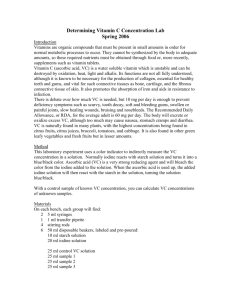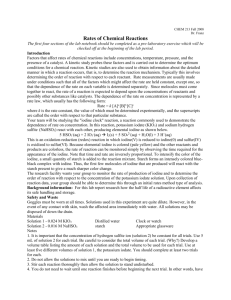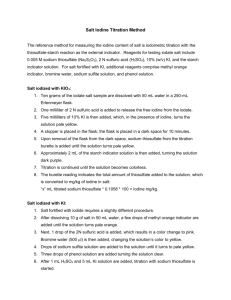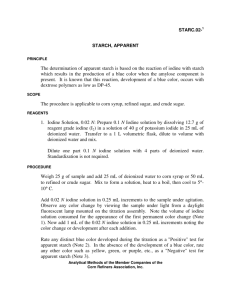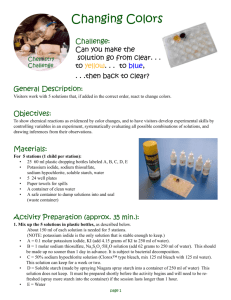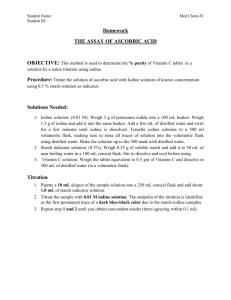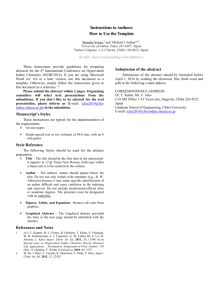Ascorbic Acid as a Standard for Iodometric Titrations. An Analytical
advertisement
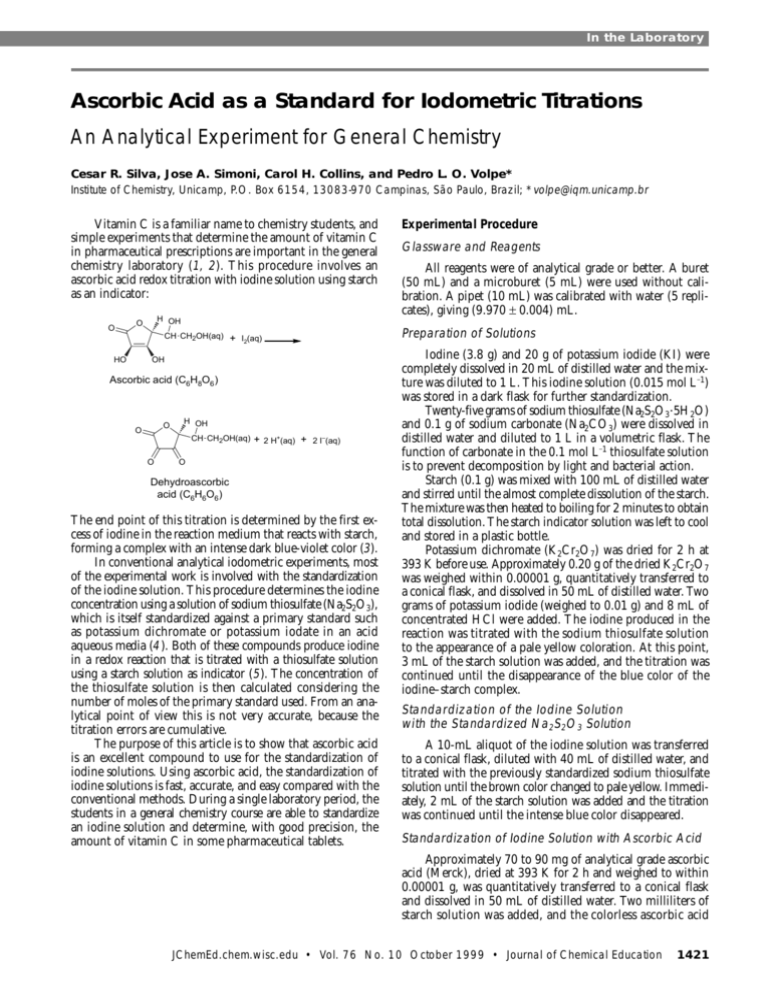
In the Laboratory
Ascorbic Acid as a Standard for Iodometric Titrations
An Analytical Experiment for General Chemistry
Cesar R. Silva, Jose A. Simoni, Carol H. Collins, and Pedro L. O. Volpe*
Institute of Chemistry, Unicamp, P.O. Box 6154, 13083-970 Campinas, São Paulo, Brazil; *volpe@iqm.unicamp.br
Vitamin C is a familiar name to chemistry students, and
simple experiments that determine the amount of vitamin C
in pharmaceutical prescriptions are important in the general
chemistry laboratory (1, 2). This procedure involves an
ascorbic acid redox titration with iodine solution using starch
as an indicator:
O
H OH
O
CH CH2OH(aq)
HO
+ I2(aq)
OH
Ascorbic acid (C6H8O6 )
O
O
H OH
CH CH2OH(aq)
O
+ 2 H+(aq) + 2 I–(aq)
O
Dehydroascorbic
acid (C6H6O6 )
The end point of this titration is determined by the first excess of iodine in the reaction medium that reacts with starch,
forming a complex with an intense dark blue-violet color (3).
In conventional analytical iodometric experiments, most
of the experimental work is involved with the standardization
of the iodine solution. This procedure determines the iodine
concentration using a solution of sodium thiosulfate (Na2S2O3),
which is itself standardized against a primary standard such
as potassium dichromate or potassium iodate in an acid
aqueous media (4). Both of these compounds produce iodine
in a redox reaction that is titrated with a thiosulfate solution
using a starch solution as indicator (5). The concentration of
the thiosulfate solution is then calculated considering the
number of moles of the primary standard used. From an analytical point of view this is not very accurate, because the
titration errors are cumulative.
The purpose of this article is to show that ascorbic acid
is an excellent compound to use for the standardization of
iodine solutions. Using ascorbic acid, the standardization of
iodine solutions is fast, accurate, and easy compared with the
conventional methods. During a single laboratory period, the
students in a general chemistry course are able to standardize
an iodine solution and determine, with good precision, the
amount of vitamin C in some pharmaceutical tablets.
Experimental Procedure
Glassware and Reagents
All reagents were of analytical grade or better. A buret
(50 mL) and a microburet (5 mL) were used without calibration. A pipet (10 mL) was calibrated with water (5 replicates), giving (9.970 ± 0.004) mL.
Preparation of Solutions
Iodine (3.8 g) and 20 g of potassium iodide (KI) were
completely dissolved in 20 mL of distilled water and the mixture was diluted to 1 L. This iodine solution (0.015 mol L{1)
was stored in a dark flask for further standardization.
Twenty-five grams of sodium thiosulfate (Na2S2O3?5H2O)
and 0.1 g of sodium carbonate (Na2CO3) were dissolved in
distilled water and diluted to 1 L in a volumetric flask. The
function of carbonate in the 0.1 mol L{1 thiosulfate solution
is to prevent decomposition by light and bacterial action.
Starch (0.1 g) was mixed with 100 mL of distilled water
and stirred until the almost complete dissolution of the starch.
The mixture was then heated to boiling for 2 minutes to obtain
total dissolution. The starch indicator solution was left to cool
and stored in a plastic bottle.
Potassium dichromate (K2Cr2O7) was dried for 2 h at
393 K before use. Approximately 0.20 g of the dried K2Cr2O7
was weighed within 0.00001 g, quantitatively transferred to
a conical flask, and dissolved in 50 mL of distilled water. Two
grams of potassium iodide (weighed to 0.01 g) and 8 mL of
concentrated HCl were added. The iodine produced in the
reaction was titrated with the sodium thiosulfate solution
to the appearance of a pale yellow coloration. At this point,
3 mL of the starch solution was added, and the titration was
continued until the disappearance of the blue color of the
iodine–starch complex.
Standardization of the Iodine Solution
with the Standardized Na2S2O3 Solution
A 10-mL aliquot of the iodine solution was transferred
to a conical flask, diluted with 40 mL of distilled water, and
titrated with the previously standardized sodium thiosulfate
solution until the brown color changed to pale yellow. Immediately, 2 mL of the starch solution was added and the titration
was continued until the intense blue color disappeared.
Standardization of Iodine Solution with Ascorbic Acid
Approximately 70 to 90 mg of analytical grade ascorbic
acid (Merck), dried at 393 K for 2 h and weighed to within
0.00001 g, was quantitatively transferred to a conical flask
and dissolved in 50 mL of distilled water. Two milliliters of
starch solution was added, and the colorless ascorbic acid
JChemEd.chem.wisc.edu • Vol. 76 No. 10 October 1999 • Journal of Chemical Education
1421
In the Laboratory
solution was immediately titrated with the iodine solution.
The titration must be performed immediately to prevent airoxidation of the ascorbic acid (6 ). The end point was determined when a pale blue color remained with the first excess
of iodine.
Determination of Vitamin C in Pharmaceutical
Preparations
A pharmaceutical tablet of 2 g of vitamin C (Redoxon,
manufactured by Roche) was ground in a beaker and then
quantitatively transferred to a 250-mL volumetric flask and
diluted to the mark with distilled water. Aliquots of the
solution were taken using a calibrated pipet and titrated with
the standardized iodine solution as described above.
Results and Discussion
The conventional chemical procedure to standardize iodine
solutions has the disadvantage of being very time consuming,
because of the two chemical reactions shown below:
Cr2O72{(aq) + 14H+(aq) + 6I{(aq) → 3I2(aq) + 2Cr3+(aq) + 7H2O
6S2O32{(aq) + 3I2(aq) → 3S4O62{(aq) + 6I {(aq)
According to these reactions, the concentration of the
Na2S2O3 solution is calculated by taking into account that
each mole of K2Cr2O7 reacts with 6 moles of Na2S2O3. Using
this conventional procedure the average value (3 replicates)
of the concentration was (0.1078 ± 0.0001) mol L{1, with a
standard deviation of less than 0.2 parts per thousand.
The next step was the standardization of the iodine solution with the standardized thiosulfate solution. The average
value (6 replicates) of the iodine concentration found was
(0.0152 ± 0.0001) mol L{1, with a standard deviation of 7
parts per thousand.
The results for the standardization of the same iodine
solution using untreated ascorbic acid as a standard gave an
average value (7 replicates) of (0.0152 ± 0.0001) mol L{1 for
the concentration of the iodine solution, corresponding to
an error of 3 parts per thousand. This value is the same as
that obtained from the standardization of the iodine solution
with standardized thiosulfate, within experimental error.
Using ascorbic acid, previously dried at 393 K for 2 h,
as the standard, the average value (3 replicates) of the iodine
concentration was (0.0152 ± 0.0001) mol L{1, the same as
used without any prior treatment. Thermogravimetric analysis
of this ascorbic acid showed that its water content was very
low (about 0.5%) even before drying, and so the standardization of the iodine solution is not affected when this pro-
1422
cedure is carried out with undried ascorbic acid.
As recommended in the literature (6 ), a standard for titration has to be readily available, of high purity, stable in air,
of relatively high molecular mass, soluble in titration solvent,
and not hygroscopic so that it can be weighed accurately. As
can be seen from the experimental results in comparison with
the conventional procedure for iodometric titrations, the use of
ascorbic acid as a standard can be suggested for this purpose. In
addition, since there are fewer steps in the overall procedure,
the cumulative experimental errors are smaller with ascorbic
acid than with thiosulfate.
However, there is the disadvantage that ascorbic acid is
not very stable when dissolved in water, because it scavenges
oxygen. Thus, care should be taken in the laboratory work,
and each titration must be performed individually immediately
after the dissolution of this standard.
The analysis of a tablet of vitamin C, Redoxon, was made
(3 replicates).The average value was (2.091 ± 0.002) g of
vitamin C per tablet with a standard deviation of less than 1
part per thousand, which is in good agreement with the value
shown in the description of the medication, provided by the
manufacturer.
Since iodometric titrations are widely used in many senior
courses, ascorbic acid can be used as a weighable standard
when the experimental procedure involves the standardization
of an iodine solution.
Conclusion
The standardization of an iodine solution using ascorbic
acid as the weighable standard was shown to be accurate and
precise. Since the titration is colorless, a clear and defined
end point is achieved using starch, with results that are identical to those obtained using the conventional analytical
procedure using standardized Na2S2O3 solution. Thus, for a
general chemistry experiment, ascorbic acid can be used
instead of thiosulfate to standardize the iodine solution,
provided that the titrations are performed immediately after
the dissolution of the ascorbic acid. Use of ascorbic acid results
in a simpler and much shorter procedure that gives good
accuracy and precision for the analysis of vitamin C in
pharmaceutical tablets.
Literature Cited
1.
2.
3.
4.
Wilk, I. J. J. Chem. Educ. 1976, 53, 41.
Haddad, P. J. Chem. Educ. 1977, 54, 192.
McAlpine, R. K. J. Chem. Educ. 1949, 26, 362.
Marsh, D. G.; Jacobs, D. L.; Veening, H. J. Chem. Educ. 1973,
50, 626.
5. Bailey, D. N. J. Chem. Educ. 1974, 51, 488.
6. Skoog, D. A.; West, D. M.; Holler, F. J. Fundamentals of Analytical Chemistry, 6th ed.; Saunders: Philadelphia, 1992; p 868.
Journal of Chemical Education • Vol. 76 No. 10 October 1999 • JChemEd.chem.wisc.edu


